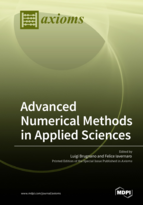Advanced Numerical Methods in Applied Sciences
A special issue of Axioms (ISSN 2075-1680).
Deadline for manuscript submissions: closed (30 April 2018) | Viewed by 70781
Special Issue Editors
Interests: geometric numerical integration; numerical methods for differential equations; numerical linear algebra; parallel algorithms in Numerical Analysis
Interests: numerical solution of ODEs with initial and boundary conditions, and in particular Hamiltonian systems; numerical solution of algebraic differential equations (DAEs); sequential and parallel software for ODE and DAE; maintenance of the test set; numerical solution of elliptical partial differential equations (PDEs); history of olomorphic dynamics; geometric integration
Special Issue Information
Dear Colleagues,
The use of scientific computing tools is, nowadays, customary for solving problems at several complexity levels in Applied Sciences. The great need for reliable software in the scientific community conveys a continuous stimulus to develop new and more performing numerical methods, able to grasp the particular features of the problem at hand. This has been the case for many different settings of Numerical Analysis and this Special Issue aims at covering some important developments in various areas of application.
Prof. Dr. Luigi Brugnano
Prof. Dr. Felice Iavernaro
Guest Editors
Manuscript Submission Information
Manuscripts should be submitted online at www.mdpi.com by registering and logging in to this website. Once you are registered, click here to go to the submission form. Manuscripts can be submitted until the deadline. All submissions that pass pre-check are peer-reviewed. Accepted papers will be published continuously in the journal (as soon as accepted) and will be listed together on the special issue website. Research articles, review articles as well as short communications are invited. For planned papers, a title and short abstract (about 100 words) can be sent to the Editorial Office for announcement on this website.
Submitted manuscripts should not have been published previously, nor be under consideration for publication elsewhere (except conference proceedings papers). All manuscripts are thoroughly refereed through a single-blind peer-review process. A guide for authors and other relevant information for submission of manuscripts is available on the Instructions for Authors page. Axioms is an international peer-reviewed open access monthly journal published by MDPI.
Please visit the Instructions for Authors page before submitting a manuscript. The Article Processing Charge (APC) for publication in this open access journal is 2400 CHF (Swiss Francs). Submitted papers should be well formatted and use good English. Authors may use MDPI's English editing service prior to publication or during author revisions.
Keywords
- ordinary differential equations
- partial differential equations
- evolutionary problems
- optimization problems
- geometric integration
Benefits of Publishing in a Special Issue
- Ease of navigation: Grouping papers by topic helps scholars navigate broad scope journals more efficiently.
- Greater discoverability: Special Issues support the reach and impact of scientific research. Articles in Special Issues are more discoverable and cited more frequently.
- Expansion of research network: Special Issues facilitate connections among authors, fostering scientific collaborations.
- External promotion: Articles in Special Issues are often promoted through the journal's social media, increasing their visibility.
- e-Book format: Special Issues with more than 10 articles can be published as dedicated e-books, ensuring wide and rapid dissemination.
Further information on MDPI's Special Issue polices can be found here.






